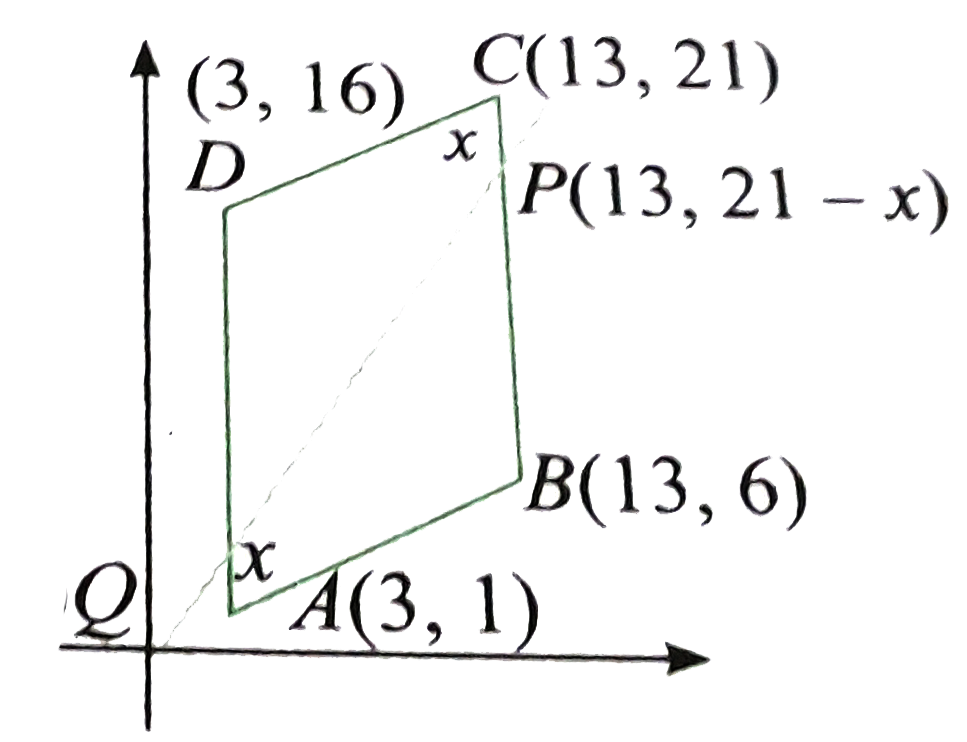The vertices of a parallelogram ABCD are A(3,1),B(13,6),C(13,21), and D(3,16). If a line passing through the origin divides the parallelogram into two congruent parts, then the slope of the line is (a) 1112 (b) 118 (c) 258 (d) 138Solution in Bengali
11/12
11/8
25/8
13/8
The correct Answer is:B
Slope of line thorugh origin is,
m=21−x13=x+13
or 63−3x=13x+13
or 16x=50
or x=258
Hence, m=(258+1)×13
=3324=118

Topper's Solved these Questions
- BOOK - CENGAGE PUBLICATIONCHAPTER - COORDINATE SYSYEM EXERCISE - Multiple correct13videos
COORDINATE SYSYEM
- BOOK - CENGAGE PUBLICATIONCHAPTER - COORDINATE SYSYEM EXERCISE - Linked10videos
COORDINATE SYSYEM
- BOOK - CENGAGE PUBLICATIONCHAPTER - COORDINATE SYSYEM EXERCISE - Concept applications 1.69videos
COORDINATE SYSYEM
- BOOK - CENGAGE PUBLICATIONCHAPTER - COORDINATE SYSTEMEXERCISE - Multiple Correct Answers Type2videos
COORDINATE SYSTEM
- BOOK - CENGAGE PUBLICATIONCHAPTER - CROSS PRODUCTS EXERCISE - DPP 2.213videos
CROSS PRODUCTS
Similar Questions
If (-6,-4), (3,5),(-2,1) are the vertices of a parallelogram, then remaining vertex cannot be
07:12View SolutionFor points P=(x1,y1)and Q=(x2,y2) of the co-ordinate plane a new distance d(P,Q)=|x1−x2|+|y1−y2| is defined .Let O(0,0)and A(3,2). The set of points in first quadrant which are equidistant from O and A is
02:34View SolutionFind the locus of a point whose distance from (a, 0) is equal to its distance from the y-axis.
02:44View SolutionCoordinates of points on curve 5x2−6xy+5y2−4=0 which are nearest to origin are
03:01View SolutionLet →a and →b be two vectors of equal magnitude 5 units. Let →p,→q be vectors such that →p=→a−→b and →q=→a+→b. If |→p×→q|=2{λ−(→a.→b)2}12, then value of λ is
01:42View SolutionThe vertices of a parallelogram ABCD are A(3,1),B(13,6),C(13,21), and D(3,16). If a line passing through the origin divides the parallelogram into two congruent parts, then the slope of the line is 1112 (b) 118 (c) 258 (d) 138
01:17View Solutiona+b=8,c-d=6,a+c=13,b+d=8 then a,b,c,dis:
01:47View SolutionR is a relation from {11, 12, 13} to {8, 10, 12} defined by y=x−3 . Then, R−1 is (a) {(8, 11), (10, 13)} (b) {(11, 8), (13, 10)} (c) {(10, 13), (8, 11), (8, 10)} (d) none of these
02:27View SolutionIn Fig. 21, ABCD is a parallelogram, DL⊥AB. If AB=20 cm , AD=13 cm and area of the parallelogram is 100 cm2 find AL.
02:59View SolutionIf A={3,5,7,9,11},B={7,9,11,13},C={11,13,15}andD={15,17}, find
A∩C∩D03:35View SolutionIf A={3,5,7,9,11},B={7,9,11,13},C={11,13,15}andD={15,17}, find
A∩C∩D06:23View SolutionIf A={3,5,7,9,11},B={7,9,11,13},C={11,13,15}andD={15,17}, find
A∩C∩D01:10View SolutionIf A={3,5,7,9,11},B={7,9,11,13},C={11,13,15}andD={15,17}, find
A∩C∩D01:43View SolutionThe vertices of a parallelogram ABCD are A(3,1),B(13,6),C(13,21), and D(3,16). If a line passing through the origin divides the parallelogram into two congruent parts, then the slope of the line is (a) 1112 (b) 118 (c) 258 (d) 138
00:42View SolutionThe vertices of a parallelogram ABCD are A(3,1),B(13,6),C(13,21), and D(3,16). If a line passing through the origin divides the parallelogram into two congruent parts, then the slope of the line is (a) 1112 (b) 118 (c) 258 (d) 138
00:42View SolutionR is a relation from {11, 12, 13} to {8, 10, 12} defined by y=x−3 . Then, R−1 is (a) {(8, 11), (10, 13)} (b) {(11, 8), (13, 10)} (c) {(10, 13), (8, 11), (8, 10)} (d) none of these
04:04View Solution

